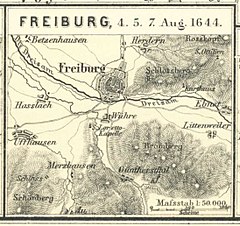Battle of Freiburg
| Battle of Freiburg | |||||||
|---|---|---|---|---|---|---|---|
| Part ofThirty Years' War | |||||||
 Condé at Freiburg | |||||||
| |||||||
| Belligerents | |||||||
| Kingdom of France |
Holy Roman Empire Electorate of Bavaria | ||||||
| Commanders and leaders | |||||||
|
Condé Turenne |
Franz von Mercy Johann von Werth | ||||||
| Strength | |||||||
| c.16,000[5][6] | c.13,000[a] | ||||||
| Casualties and losses | |||||||
| c.8,000 | c.4,000 | ||||||
TheBattle of Freiburg,fought over three days on 3, 5, and 9 August 1644, took place during theThirty Years' War,nearFreiburg im Breisgau,now inBaden-Württemberg.AFrencharmy of 16,000, led jointly byCondéandTurenne,sought to relieve the town, which had recently surrendered to aBavarianforce underFranz von Mercy.In what has been described as the bloodiest battle of the war, around half of the French soldiers engaged were killed or wounded, with the Bavarians losing up to a third of theirs. The French claimed victory since Mercy was forced to withdraw, but the result is disputed.
Having captured Freiburg on 28 July, Mercy placed his men in strong defensive positions on the hills outside the town, which the French attacked on 3 and 5 August. Although the assaults made little progress and incurred severe losses, the Bavarians also suffered heavy casualties and were short of supplies. On 9 August, Mercy learned a detachment under Turenne was marching into his rear to cut off his supply lines, and ordered a general retreat, leaving a garrison in Freiburg. Apart from a brief skirmish with Turenne's cavalry next day, they withdrew in good order, despite abandoning their baggage train and several guns.
Nevertheless, Freiburg convincedMaximilian I, Elector of Bavaria,that the war could not be won and he began negotiating peace terms. Mercy was ordered to suspend offensive operations, ceding France the strategic initiative, and allowing Condé and Turenne to take control of most of the northernUpper Rhine.
Background
[edit]A decisiveSwedishvictory atBreitenfeldin November 1642 secured control of Northern Germany, while in 1643 their French allies took the offensive in theRhineland.On 18 November 1643, a French army capturedRottweil,which they intended to use as a winter base, but their commanderGuébriant,was mortally wounded during the siege. On 24 November, his successorJosias von Rantzauwas ambushed atTuttlingenby aBavarian-Imperialarmy underFranz von MercyandJohann von Werth.[9]Taken by surprise, the French force of 16,000 effectively disintegrated, with more than two thirds killed, wounded, or captured either during the battle, or afterwards as they retreated intoAlsace.[10]
Rantzau was among the prisoners and he was replaced byTurenne,who took urgent steps to rebuild his shattered army.[b]The French position was further weakened when Sweden initiated theTorstenson WarwithDenmark-Norwayin December 1643, diverting resources and attention away from Germany. Over the winter of 1643/1644, Mercy used the opportunity to seize control of large areas along theUpper Rhine,Swabiaand theBreisgau.[12]
For the 1644 summer campaign,Maximilian I, Elector of Bavaria,decided to capitalise by forcing Turenne out of his bases on the Rhine. To achieve this, on 11 May Mercy first secured his rear by capturingÜberlingenonLake Constance,then advanced on the French-held town ofFreiburg.After some skirmishing with Turenne in theBlack Forest,he arrived outside Freiburg on 16 June, and began siege operations.[13]
Turenne, who had withdrawn toBreisach,was ordered to relieve Freiburg, which he reached on 1 July with around 8,000 men. By this time, the Bavarians had established strong positions in the mountains atSchönbergandLorettoberg,as well as a series of redoubts along the plain in front of the town.[7]When his initial assault was repulsed, Turenne broke off the attack and demanded reinforcements fromCardinal Mazarin.[14]On 2 August, 9,000 men arrived in Breisach fromFlanders,led byCondé,although Freiburg itself had surrendered on 28 July.[c]As he was senior to Turenne, Condé assumed overall command, and decided to attack the following day.[15]
Battle; 3 and 5 August
[edit]
There were lengthy debates over the French plan of attack, which were later recorded by several of those present. It was ultimately agreed Condé would assault Mercy's defences on the Schönberg which blocked the main road into Freiburg, while Turenne made a flanking march viaWittnauagainst the village ofMerzhausenin their rear (see Battle map right).[16]To ensure both happened simultaneously, Condé delayed his operations until 17:00 to give Turenne time to move into position.[17]
Despite the difficult ground over which he had to manoeuvre, Turenne began his attack as planned. However, he was driven back by Mercy's reserves of infantry and supporting cuirassiers, and unable to make progress against determined resistance.[18]Meanwhile, ignoring the protests of his subordinates, Condé personally led the assault on the Schönberg. His men took the positions after several hours of fighting, but suffered heavy casualties doing so, while it was now too dark to follow up their success. Although Turenne had finally resumed his advance, many of his men were still coming up, slowed by heavy rain, and at midnight the two commanders agreed to halt operations.[19]
Mercy used this pause to withdraw his troops to new positions at the Lorettoberg. Driving the Imperial-Bavarian forces off the Schönberg allowed Condé and Turenne to reunite their troops at Merzhausen, five kilometres outside Freiburg. However, they still faced a series of formidable defensive entrenchments, while persistent rain meant no fighting was possible on 4 August.[20]
Deciding the only other choice was to retreat, on 5 August the French commanders opted for frontal assaults against entrenchments along the Lorettoberg and atWiehre.These degenerated into a series of bloody and poorly co-ordinated firefights, which continued for most of the day. When night came, Mercy had held his ground, but two days of fighting had reduced his force by a third, with the French having lost half the number of men engaged.[21]
Battle; 9 August
[edit]
The French spent the next three days evacuating their wounded to Breisach, and gathering 5,000 replacements from local garrisons for their next attack. While Condé remained in Merzhausen to occupy Mercy, early on 9 August Turenne took 6,000 men and began marching into his rear atDenzlingen,five kilometres north of Freiburg. Since this would cut off the escape route toVillingen,the French commanders hoped Mercy would be forced to fight, or make a hurried flight.[d][23]
However, Mercy had already decided to withdraw. Two days of battle had reduced his strength to around 6,000 men, who were short of both ammunition and food. The problem was especially acute for his cavalry, essential for covering the retreat but whose combat effectiveness was quickly declining due to lack offoragefor their horses. Leaving a hand-picked garrison to hold Freiburg, on 9 August the rest of his army began falling back onSt. Peter,which controlled the road to Villingen.[24]On the morning of 10 August, Turenne's cavalry caught up with the Bavarian rearguard just outside the village, forcing them to abandon several guns and some baggage.[25]Despite this, Mercy reachedRottenburg am Neckaron 15 August without incident.[24]
Total casualties for the three days of battle were enormous on both sides. Périni suggests French losses were around 50%, or 8,000, those of the Bavarians about a third, or 3,000.[26]Other estimates range from 5,000 to 8,000 for the French,[27][23]and 2,500 to 6,800 for the Bavarians.[23][28][27]At the time, the French claimed victory because Mercy's retreat left them in possession of the battlefield, a view supported by a number of historians.[29][6]Others suggest it can also be seen as a draw,[1]or a Bavarian tactical victory, as they fought off the French assaults and inflicted heavy casualties.[4][2]
Aftermath
[edit]
Mercy still controlled most of Swabia, but his losses led Maximilian to ban any further offensive action, while his retreat to Rottenburg left the Upper Rhine exposed. Turenne convinced Condé not to waste the rest of the summer retaking Freiburg, but instead march north to capturePhilippsburg,which surrendered on 12 September.[30]After this, the French went on to occupyWorms,Oppenheim,Mainz,andLandau,leaving them in control of the Rhine valley.[25]
Maximilian was now convinced the war could no longer be won, and put pressure onEmperor Ferdinandto restart peace negotiations.[31]These began in November 1644, although fighting continued as both sides tried to improve their negotiating position. Much of the veteran Bavarian cavalry was lost atJankauin March 1645, while in May Mercy destroyed a French detachment atHerbsthausen.[32]He in turn was defeated and killed atSecond Nördlingenin August, depriving Maximilian of his most effective military commander.[33]
Notes
[edit]- ^The number present during the battle is unclear. According to Périni, Mercy reached Freiburg in June with 15,000 men. Schaufler reports he lost 1,600 men during the siege that preceded the battle.[7][8]
- ^This was composed primarily of German mercenaries known asWeimaransorBernhardines,formerly employed byBernard of Saxe-Weimar(1604-1639). Unlike Guébriant, who had formerly served under Bernard, Turenne was an outsider; many of those who escaped Tuttlingen had not been paid for months, and were on the verge of mutiny, forcing Turenne to pay for supplies himself[11]
- ^Turenne criticised the garrison commander for his "premature surrender", while Condé tried to have him executed.[15]
- ^Like the French afterTuttlingen,or the Imperials afterJankau,armies which retreated in disorder often disintegrated entirely.[22]
References
[edit]- ^abSchaufler 1979,p. 120.
- ^abSchott 1978,p. 12.
- ^Thion 2008,p. 135.
- ^abWilson 2009,p. 684.
- ^Périni 1904,p. 57.
- ^abZabecki 2014,p. 437.
- ^abPérini 1904,p. 50.
- ^Schaufler 1979,p. 65.
- ^Eggenberger 2012,p. 450.
- ^Parker 1984,p. 157.
- ^Périni 1904,p. 47.
- ^Zabecki 2014,p. 436.
- ^Bonney 2014,p. 71.
- ^Godley 1915,p. 92.
- ^abPérini 1904,p. 56.
- ^Schaufler 1979,pp. 72–74.
- ^Guthrie 2003,p. 204.
- ^Schaufler 1979,pp. 83–84.
- ^Godley 1915,pp. 100–101.
- ^Périni 1904,pp. 61–62.
- ^Périni 1904,pp. 62–65.
- ^Parker 1984,p. 182.
- ^abcGuthrie 2003,p. 212.
- ^abPérini 1904,pp. 66–67.
- ^abGuthrie 2003,p. 214.
- ^Périni 1904,p. 65.
- ^abClodfelter 2017,p. 39.
- ^Bodart 1908,p. 72.
- ^Thion 2008,p. 29.
- ^Wilson 2009,pp. 683–684.
- ^Croxton 1998,p. 273.
- ^Guthrie 2003,pp. 214–217.
- ^Guthrie 2003,pp. 221–223.
Sources
[edit]- Bodart, Gaston (1908).Militär-historisches Kriegs-Lexikon (1618-1905).Retrieved9 January2022.
- Bonney, Richard (2014).The Thirty Years' War 1618–1648.Bloomsbury Publishing.ISBN978-1-4728-1002-1.
- Croxton, Derek (1998). "A Territorial Imperative? The Military Revolution, Strategy and Peacemaking in the Thirty Years War".War in History.5(3): 253–279.doi:10.1177/096834459800500301.JSTOR26007296.S2CID159915965.
- Croxton, Derek (2000). ""The Prosperity of Arms Is Never Continual": Military Intelligence, Surprise, and Diplomacy in 1640s Germany ".The Journal of Military History.64(4): 981–1003.doi:10.2307/2677264.JSTOR2677264.
- Clodfelter, M. (2017).Warfare and Armed Conflicts: A Statistical Encyclopedia of Casualty and Other Figures, 1492-2015(4th ed.). Jefferson, North Carolina: McFarland.ISBN978-0-7864-7470-7.
- Eggenberger, David (2012).An Encyclopedia of Battles: Accounts of Over 1,560 Battles from 1479 B.C. to the Present.Courier Corporation.ISBN978-0-486-14201-2.
- Godley, Eveline Charlotte (1915).The Great Condé, a life of Louis II de Bourbon, Prince of Condé.John Murray.
- Guthrie, William P. (2003).The Later Thirty Years War: From the Battle of Wittstock to the Treaty of Westphalia.Greenwood Publishing Group.ISBN978-0-313-32408-6.
- Parker, Geoffrey, ed. (1984).The Thirty Years' War(1997 ed.). Routledge.ISBN0-203-99549-X.OCLC252816798.
- Périni, Colonel Hardy de (1904).Batailles françaises. 4e série(in French). Flammarion.
- Schaufler, Hans-Helmut (1979).Die Schlacht bei Freiburg im Breisgau 1644(in German). Rombach.ISBN978-3793002239.
- Schott, Rudolf (1978)."Die Kämpfe vor Freiburg im Breisgau, die Eroberung von Philippsburg und die Belagerungen mehrerer Städte am Rhein im Jahre 1644".Militärgeschichtliche Zeitschrift(in German).24(2): 9–22.doi:10.1524/mgzs.1978.24.2.9.
- Thion, Stéphane (2008).French Armies of the Thirty years War.LRT Editions.ISBN978-2-917747-01-8.
- Wilson, Peter (2009).Europe's Tragedy: A History of the Thirty Years War.Allen Lane.ISBN978-0713995923.
- Zabecki, David T (2014).Germany at War: 400 Years of Military History [4 volumes]: 400 Years of Military History.ABC-CLIO.ISBN978-1-59884-981-3.


